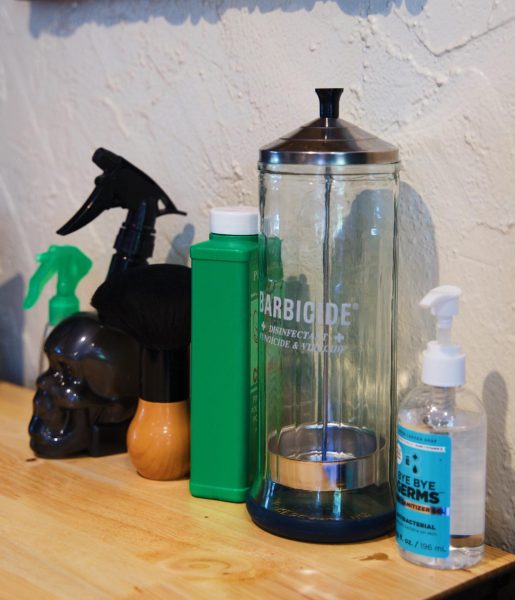Schools facing backlash over dress code
LOCAL NEWS
October 7, 2021
According to a survey sent to 90 Lauderdale County School System students, both current and former, 84.3% have been “dress coded.” Dress coding refers to the clothes a student is wearing being deemed inappropriate for school, usually by school faculty or administration.
While the school system has a set of rules, individual schools can add extra rules as they see fit, according to the handbook. A few examples from the LCSS handbook include: “Students shall not wear midriff shirts, tube tops, spandex, mesh, fishnet garments, backless tops, strapless tops, tops or dresses with spaghetti straps, tank tops, halter tops or pajamas in grades 5-12”; “Students shall not wear anything on his/her head inside the school building (toboggans, bandannas, caps, scarves, hats, etc.)”; “Skirts or dresses must be no more than two inches above the knees. Skirts or dresses with slits in the sides, front or back must not be more than two inches above the knee.” Most of these rules begin in the fifth grade, though some, such as the promotion of profane content, are for every grade level.
Of the students surveyed, 87.8% were female and 12.2% were male. No students reported being non-binary or other. The most common reason for students being dress coded was ripped jeans (52), and the most common punishment was duct tape being placed either over the rip or directly on the student’s skin (30). The least common reason was wearing a hat to class (2), and the least common punishment was writing honor codes (2).
A male student from Brooks High School reported being verbally reprimanded by a teacher as a result of wearing shorts to class, and a female student from Wilson High School shared a similar punishment for her shirt being too short, despite claiming no midriff showed. Eight students also reported being sent to in school suspension (ISS) or detention as a result of their dress code violation. Even then, a majority of the students did not wish for an eradication of dress code, but rather less strict rules.
The survey found that 52.8% of the students reported that the current dress code has an effect on their self-esteem. Of the remaining students, 27% said that it did not affect their self-esteem and 20.2% were not sure if it did or not. Most students share a feeling as though they are unable to express themselves properly with the restrictions put upon them. Results found that 89.9% of students also noticed a big difference between the dress code expectations of males and of females.
“It made me feel like if I was skinnier then I wouldn’t have been dress coded,” a female Brooks High School student said.
Other students expressed a similar sentiment.
“It made me feel sexualized,” a female student from Waterloo High School said. “It was a male teacher who dress coded me. It was about half an inch above my knee. How was that going to distract anyone?”
Anti-dress code sentiments have been extremely prevalent in the media in recent years. In 2014, a Florida high school came under attack for doling out a “shame shirt,” a neon yellow top with the words “DRESS CODE VIOLATION” printed on the front. Students who broke the dress code were forced to wear it, despite what the violation was.
In 2016, students at a Chicago school protested their school’s dress code until a new code of conduct was introduced the following school year.
In 2018, 17-year-old Florida student Lizzy Martinez was removed from class for not wearing a bra to school. She was forced to put a t-shirt over her shirt and bandages over nipples. According to Martinez, she was also told to move around and jump up and down so the dean could “see the motion in [her] breasts.” The biggest complaint among students is the disproportionately large number of dress code violations doled out to women.
Natalie Chidoni, a Wilson High School freshman, took notice of the issues with dress code at her school. According to Chidoni, she has always found issues within the dress code but wasn’t given a violation until seventh grade. She has recently become somewhat of a folk hero among her fellow LCSS students after making a petition on change.org calling for a change to the school system’s dress code. As of Sept. 29, 2021, the petition has 2,920 signatures and $61 have been donated. Chidoni and a few of her friends were also featured in a segment on WAAY-31’s evening news program, sporting shirts that read “I AM NOT A DISTRACTION.”
“I feel like dress code really encourages rape culture and the sexualization of young women,” Chidoni said. “There definitely needs to be a dress code, but I feel like if they were to lower the dress code standards, that would be a lot easier for us. Some people don’t have the privilege of having enough money to buy clothes just for school. I just feel like it sexualizes girls from a young age.”
At Chidoni’s school, if a student breaks dress code they are usually taken from class to retrieve a change of clothes from the “lost and found” collection. She has been pulled from class in the middle of a math test and taken across campus to find a change of clothes for twenty minutes. Sometimes students are sent to ISS without even having a chance to change clothes.
The girls of Wilson are not alone in their cause. Chidoni reports overwhelming support from students and parents around Lauderdale County. As the survey shows, many students share the same feelings as Chidoni, though she was the first to openly speak about it on platforms as public as change.org and Instagram. In her opinion, the dress code encourages the practice of body shaming. Body shaming, according to the Merriam-Webster dictionary, is “the act or practice of subjecting someone to criticism or mockery for supposed body faults or imperfection.” Low self-esteem has become more and more prevalent among high school students in recent years and Chidoni thinks that strict dress codes perpetuate that.
“Every teenage girl is going to go through some kind of self-confidence issues; I know I have, and the dress code doesn’t help,” said Chidoni.
In recent years, opposition against dress code has become increasingly prevalent. Protests, petitions and formal complaints have risen in number over time. This may be Lauderdale County’s first public complaint, but it likely won’t be their last. Students have only grown more outspoken in their endeavors. Reports have emerged of groups of Lauderdale County students purposefully breaking dress code in the wake of the petition.
“I’m just really trying to make some kind of a change, even if it’s something small,” Chidoni said. “I just truly want to see a little bit of a change within the standards that they hold us to.”
Regarding the recent comments, the Lauderdale County Board of Education says they “don’t have any comment regarding the protests.”














